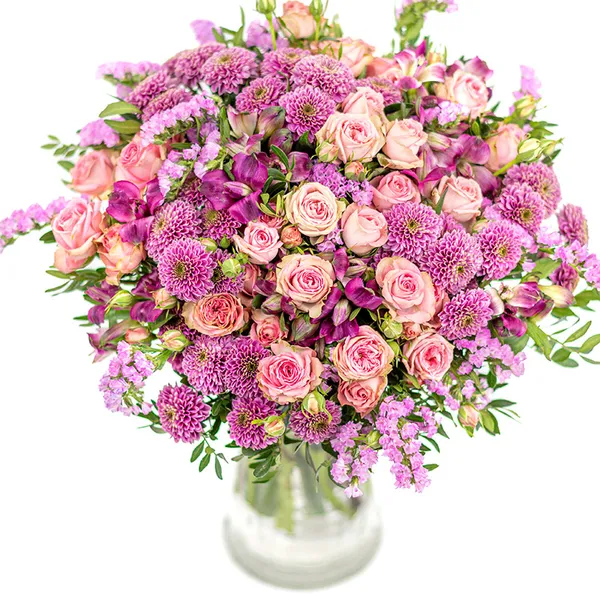Chrysanthemums: Vibrant Symbols of Loyalty and Joy
Chrysanthemums, often called mums, are highly popular flowers known for their vibrant colours and unique petal arrangements. These blooms are symbols of longevity, loyalty, and joy, with cultural significance across the globe, especially in Asia, where they are associated with honour and respect. Available in a wide variety of forms and sizes, chrysanthemums are a favourite for both gardens and floral arrangements. Their adaptability and long vase life make them a staple for autumn displays, festivals, and celebrations.
COMMON NAME
Chrysanthemum
BOTANICAL NAME
Chrysanthemum spp.
ORIGIN
Asia, primarily China and Japan
PEOPLE ALSO CALL IT
Mums, Chrysanths
FLOWERING TIME
Autumn (September to November)
ASPECT
Full sun
SYMBOLISM
Longevity, joy, honour, loyalty, grief (in some cultures)
Care Tips for a Cut Chrysanthemums in a Vase
Trim Stems at an Angle: Cut the stems diagonally to maximize water absorption.
Remove Lower Leaves: Strip leaves that would sit below the waterline to reduce bacteria growth.
Use Floral Preservative: Add flower food to the water to keep the blooms fresh for longer.
Change Water Regularly: Replace the water every two to three days to maintain freshness.
Keep in a Cool Spot: Place the vase in a cool area, away from direct sunlight and heat sources.
Symbolism & Meaning
Chrysanthemums carry rich symbolism that varies by culture. In many Western traditions, they symbolise joy, friendship, and longevity, making them a cheerful gift. In Japan, they are a symbol of the emperor and are associated with nobility and honour. However, in some European countries, particularly in France and Belgium, chrysanthemums are linked with mourning and are commonly used in funerals and to honour the dead. Their ability to convey a range of emotions makes them versatile and meaningful.
Types of Chrysanthemums
Chrysanthemums come in a variety of forms, classified by the arrangement of their petals. Decorative Mums have densely packed petals that form a dome shape, making them a popular choice for arrangements. Pompon Mums are small, round, and compact, ideal for button-like accents. Spider Mums feature long, curling petals that give them an exotic, spidery appearance. Anemone Mums have a central button surrounded by shorter petals, resembling an anemone flower. With such diversity, chrysanthemums can fit any aesthetic, from classic to modern floral designs.
Frequently Asked Questions About Chrysanthemums
Yes, some chrysanthemums are frost-resistant, particularly garden chrysanthemums (Chrysanthemum morifolium), also known as "hardy mums." These varieties can survive winter in German winters, provided they are planted early enough in the season to establish strong roots before frost.
To improve their frost resistance:
- Mulch heavily after the first frost to insulate the roots.
- Avoid cutting back the foliage in fall; it can provide extra protection.
- Florist chrysanthemums, often sold as potted plants, are generally not winter-hardy and are grown as annuals.
Chrysanthemums typically bloom in late summer to fall, with their peak bloom period being September to November. They are often associated with autumn gardens due to their late blooming nature.
Some varieties can bloom earlier in mid-summer if planted in spring and provided with long daylight exposure
Yes, chrysanthemums are toxic to cats. They contain compounds like pyrethrins and sesquiterpene lactones, which can cause symptoms such as vomiting, diarrhea, drooling, and skin irritation if ingested or touched.
If you suspect your cat has come into contact with or eaten chrysanthemums, contact a veterinarian immediately.
Chrysanthemums can be mildly toxic to humans. Skin contact may cause irritation or allergic reactions, and ingestion can lead to nausea, vomiting, or diarrhea. Pollen may irritate sensitive individuals. To avoid issues, wear gloves when handling them, wash hands after, and keep them out of reach of children.
Chrysanthemums typically bloom for 4-8 weeks, depending on the variety and care. Removing spent flowers (deadheading) and maintaining proper watering and fertilization can extend the blooming period.
Planting:
- Plant chrysanthemums in spring to allow their root systems to establish before winter.
- Choose a sunny spot with well-draining soil enriched with compost or organic matter.
Watering:
Keep the soil consistently moist but not waterlogged. Deep watering encourages healthy root growth.
Fertilizing:
Use a balanced fertilizer (10-10-10) every 2-4 weeks during the growing season to promote lush foliage and abundant blooms.
Pruning:
Pinch back the growing tips several times in spring and early summer to encourage bushier growth and more flowers.
Winter Care:
- For hardy varieties, mulch heavily in fall to protect the roots.
- For non-hardy varieties, either treat them as annuals or dig up the roots and store them in a cool, dark place indoors over winter.
Yes, most of them are! Chrysanthemums are typically perennial, which means they’ll come back year after year if you treat them right. That said, it depends a little on the variety and your local climate. In mild winters, they’re quite happy outdoors. Just give them a cosy spot, a little trim after flowering, and they’ll reward you with those lovely blooms again next autumn!
If you’d like your chrysanthemums to be in full bloom for All Saints’ Day (1st November), timing is everything. Generally, you’ll want to plant young chrysanthemum plants in spring (April to May) so they have the whole summer to settle in. They’ll naturally flower in late October to early November.
Pro tip: go for late-flowering varieties and give them a sunny spot. That way, you’ll have the best chance of those perfect autumn blooms right on time!




